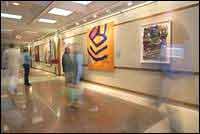| Medical masterpiece
Cleveland Clinic creates program to push for boost in the hospital’s art collection
By SHANNON MORTLAND — 6:00 am, January 2, 2006
Sit in the bustling main lobby at the Cleveland Clinic's main campus and you'll notice that passers-by stop to look at the bright and colorful artwork lining the corridor's otherwise beige walls. Those admirers likely have other things on their minds, but the artwork takes precedent for a brief moment.
The Cleveland Clinic wants to see more of that type of response, so it has created the Art in Medicine program, under which it will reach out to donors and potential benefactors to boost its art collection, said August Napoli Jr., the Clinic's vice chairman of institutional relations.
'We want to transform a sterile environment to a much more warm and comfortable environment,' he said.
That's not to say the Clinic currently is all white walls and stainless steel medical equipment. Its walls boast a photographic timeline of the Clinic, drawings, various photos and paintings. The hospital always has put art on its walls and has accepted donated artwork, but Mr. Napoli said the Clinic now is becoming active in obtaining such gifts in an effort to enhance the healing environment.
 |
The Cleveland Clinic has created the Art in Medicine program, which will reach out to donors and potential benefactors to boost the hospital's art collection.
Photo credit: JANINE BENTIVEGNA |
'We're looking for art from anywhere and anyone that is consistent with the healing plan for the space in which it will be displayed,' he said. 'We're not looking for artists to send us art — we're looking for people to be engaged in the process.'
For example, if someone wants to donate artwork to the Children's Hospital, they'll need to think about whether it will be appropriate and whether it would be approved by the Clinic's Aesthetics Committee, which is overseen by chief of staff Dr. Joseph Hahn, Mr. Napoli said.
'You're not going to want to put into the Children's Hospital art that would frighten a child,' Mr. Napoli said. 'It has to have some coherence. Art needs to speak to the healing process.'
It long has been known that art creates a mood for a room and can influence the mood of the person looking at it. Many medical professionals also believe art has the power to speed up a patient's recovery, Mr. Napoli said.
Calming influence
'We all know that there's a calming nature to art,' he said. 'It would make some sense, then, that physicians would be aware of that.'
Indeed, the Center for Therapy through the Arts in Cleveland is the oldest art therapy program in the country, said Mickie McGraw, co-founder and education coordinator for the center. It provides programs to help people heal through art, working specifically with patients at the Clinic and MetroHealth Medical Center.
In her 38 years as an art therapist, Ms. McGraw said she has seen art positively affect hospital patients.
'If you're stuck in a room, that artwork is the landscape. It has the power to relax a person and help them cope with or deal with the stress that is going on,' she said. 'It can be calming and take them to a place outside of themselves.'
Ms. McGraw noted that dialysis patients who looked at art experienced reduced heart rates and blood pressure as well as a reduced focus on their pain.
Schoolkids pitch in
And it doesn't need to be artwork by renowned artists to make a difference, said Carol Wallace, director of public relations for Akron Children's Hospital. Though the hospital buys art from professional, local and amateur artists, many of its 1,500 pieces come from schoolchildren throughout Northeast Ohio, she said.
No matter the age, patients love seeing artwork in the hospital, Ms. McGraw said. Patients at MetroHealth even get to choose the artwork they want to hang in their room if they're going to be at the hospital for a long time, she said.
Mr. Napoli said the Clinic's new Art in Medicine program won't just focus on framed art; it also will encourage people to donate statues, glassworks and fine crafts.
Though not as prevalent as the paintings, the Clinic's three-dimensional pieces don't go unnoticed. On a recent Friday, two preschool-age boys walked with a man through the Clinic's main lobby. As they passed the stone statue of a woman holding a flower, they pointed and smiled. ■
|

